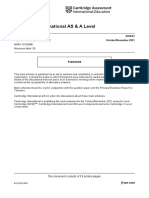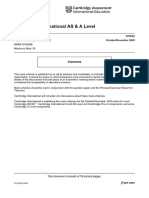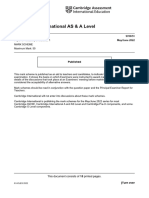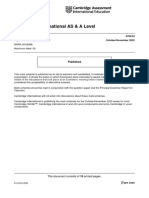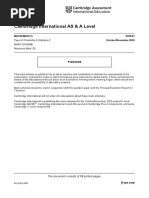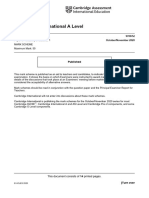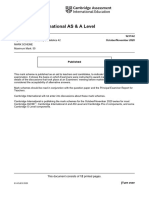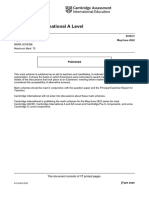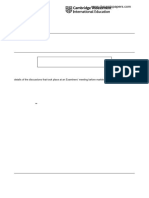Question Paper
Uploaded by
12310-214Question Paper
Uploaded by
12310-214Cambridge International AS & A Level
MATHEMATICS 9709/62
Paper 6 Probability & Statistics 2 May/June 2022
MARK SCHEME
Maximum Mark: 50
Published
This mark scheme is published as an aid to teachers and candidates, to indicate the requirements of the
examination. It shows the basis on which Examiners were instructed to award marks. It does not indicate the
details of the discussions that took place at an Examiners’ meeting before marking began, which would have
considered the acceptability of alternative answers.
Mark schemes should be read in conjunction with the question paper and the Principal Examiner Report for
Teachers.
Cambridge International will not enter into discussions about these mark schemes.
Cambridge International is publishing the mark schemes for the May/June 2022 series for most
Cambridge IGCSE, Cambridge International A and AS Level and Cambridge Pre-U components, and some
Cambridge O Level components.
This document consists of 13 printed pages.
© UCLES 2022 [Turn over
9709/62 Cambridge International AS & A Level – Mark Scheme May/June 2022
PUBLISHED
Generic Marking Principles
These general marking principles must be applied by all examiners when marking candidate answers. They should be applied alongside the specific content of the
mark scheme or generic level descriptors for a question. Each question paper and mark scheme will also comply with these marking principles.
GENERIC MARKING PRINCIPLE 1:
Marks must be awarded in line with:
the specific content of the mark scheme or the generic level descriptors for the question
the specific skills defined in the mark scheme or in the generic level descriptors for the question
the standard of response required by a candidate as exemplified by the standardisation scripts.
GENERIC MARKING PRINCIPLE 2:
Marks awarded are always whole marks (not half marks, or other fractions).
GENERIC MARKING PRINCIPLE 3:
Marks must be awarded positively:
marks are awarded for correct/valid answers, as defined in the mark scheme. However, credit is given for valid answers which go beyond the scope of the
syllabus and mark scheme, referring to your Team Leader as appropriate
marks are awarded when candidates clearly demonstrate what they know and can do
marks are not deducted for errors
marks are not deducted for omissions
answers should only be judged on the quality of spelling, punctuation and grammar when these features are specifically assessed by the question as
indicated by the mark scheme. The meaning, however, should be unambiguous.
GENERIC MARKING PRINCIPLE 4:
Rules must be applied consistently, e.g. in situations where candidates have not followed instructions or in the application of generic level descriptors.
GENERIC MARKING PRINCIPLE 5:
Marks should be awarded using the full range of marks defined in the mark scheme for the question (however; the use of the full mark range may be limited
according to the quality of the candidate responses seen).
GENERIC MARKING PRINCIPLE 6:
Marks awarded are based solely on the requirements as defined in the mark scheme. Marks should not be awarded with grade thresholds or grade descriptors in
mind.
© UCLES 2022 Page 2 of 13
9709/62 Cambridge International AS & A Level – Mark Scheme May/June 2022
PUBLISHED
Mathematics Specific Marking Principles
1 Unless a particular method has been specified in the question, full marks may be awarded for any correct method. However, if a calculation is required then
no marks will be awarded for a scale drawing.
2 Unless specified in the question, answers may be given as fractions, decimals or in standard form. Ignore superfluous zeros, provided that the degree of
accuracy is not affected.
3 Allow alternative conventions for notation if used consistently throughout the paper, e.g. commas being used as decimal points.
4 Unless otherwise indicated, marks once gained cannot subsequently be lost, e.g. wrong working following a correct form of answer is ignored (isw).
5 Where a candidate has misread a number in the question and used that value consistently throughout, provided that number does not alter the difficulty or
the method required, award all marks earned and deduct just 1 mark for the misread.
6 Recovery within working is allowed, e.g. a notation error in the working where the following line of working makes the candidate’s intent clear.
© UCLES 2022 Page 3 of 13
9709/62 Cambridge International AS & A Level – Mark Scheme May/June 2022
PUBLISHED
Mark Scheme Notes
The following notes are intended to aid interpretation of mark schemes in general, but individual mark schemes may include marks awarded for specific reasons
outside the scope of these notes.
Types of mark
M Method mark, awarded for a valid method applied to the problem. Method marks are not lost for numerical errors, algebraic slips or errors in units.
However, it is not usually sufficient for a candidate just to indicate an intention of using some method or just to quote a formula; the formula or idea
must be applied to the specific problem in hand, e.g. by substituting the relevant quantities into the formula. Correct application of a formula
without the formula being quoted obviously earns the M mark and in some cases an M mark can be implied from a correct answer.
A Accuracy mark, awarded for a correct answer or intermediate step correctly obtained. Accuracy marks cannot be given unless the associated method
mark is earned (or implied).
B Mark for a correct result or statement independent of method marks.
DM or DB When a part of a question has two or more ‘method’ steps, the M marks are generally independent unless the scheme specifically says otherwise;
and similarly, when there are several B marks allocated. The notation DM or DB is used to indicate that a particular M or B mark is dependent on
an earlier M or B (asterisked) mark in the scheme. When two or more steps are run together by the candidate, the earlier marks are implied and full
credit is given.
FT Implies that the A or B mark indicated is allowed for work correctly following on from previously incorrect results. Otherwise, A or B marks are
given for correct work only.
A or B marks are given for correct work only (not for results obtained from incorrect working) unless follow through is allowed (see abbreviation FT above).
For a numerical answer, allow the A or B mark if the answer is correct to 3 significant figures or would be correct to 3 significant figures if rounded (1
decimal place for angles in degrees).
The total number of marks available for each question is shown at the bottom of the Marks column.
Wrong or missing units in an answer should not result in loss of marks unless the guidance indicates otherwise.
Square brackets [ ] around text or numbers show extra information not needed for the mark to be awarded.
© UCLES 2022 Page 4 of 13
9709/62 Cambridge International AS & A Level – Mark Scheme May/June 2022
PUBLISHED
Abbreviations
AEF/OE Any Equivalent Form (of answer is equally acceptable) / Or Equivalent
AG Answer Given on the question paper (so extra checking is needed to ensure that the detailed working leading to the result is valid)
CAO Correct Answer Only (emphasising that no ‘follow through’ from a previous error is allowed)
CWO Correct Working Only
ISW Ignore Subsequent Working
SOI Seen Or Implied
SC Special Case (detailing the mark to be given for a specific wrong solution, or a case where some standard marking practice is to be varied in the
light of a particular circumstance)
WWW Without Wrong Working
AWRT Answer Which Rounds To
© UCLES 2022 Page 5 of 13
9709/62 Cambridge International AS & A Level – Mark Scheme May/June 2022
PUBLISHED
Question Answer Marks Guidance
1(a) M1 Expression of correct form (allow only one side for M1).
72.3 ± z 64.3 Must be a z value
50
z = 1.751 B1 Accept 1.75 if nothing better seen
CI is 70.3 to 74.3 metres (3 s.f.) A1 Allow without units Must be an interval
1(b) Not random sample B1 Need ‘random’ or ‘not representative/biased because…’
OE
© UCLES 2022 Page 6 of 13
9709/62 Cambridge International AS & A Level – Mark Scheme May/June 2022
PUBLISHED
Question Answer Marks Guidance
2 H0: Pop mean height = 2.3 B1 Not just ‘mean’
H1: Pop mean height > 2.3 Allow μ
2.4 2.3 M1 For standardising, must have 60
0.4
60
1.936 or 1.937 or 1.94 A1
‘1.936’ < 1.96 M1 Valid comparison with 1.96
Or 2.64% > 2.5% OE
Accept 1.936 < 2.24 or 2.64% > 1.25% OE if H1µ ≠ 2.3
[Do not reject H0] A1 FT FT their z
No evidence that (mean) height (with fertiliser) is more than without In context, not definite. E.g. not ‘Mean height is not
greater’ with no contradictions
No FT for 2 tail test (max B0 M1 A1 M1 A0 3/5)
Accept critical values method 2.401 (M1 A1) 2.4 < 2.401
(M1) Condone 2.299 (M1 A1) < 2.3 (M1)
A1 conclusion
© UCLES 2022 Page 7 of 13
9709/62 Cambridge International AS & A Level – Mark Scheme May/June 2022
PUBLISHED
Question Answer Marks Guidance
3(a) Poisson B1 SOI
Mean = 3.6 B1 Can be awarded for N(3.6, …)
2 M1 Allow any λ
e-3.6(1 + 3.6 + 3.6 )
2 Allow one end error
Expression must be seen
0.303 (3 s.f.) A1 If M0 awarded allow SC B1 for 0.303
SC Use of binomial: B1 for answer 0.300 (3 sf)
3(b) [Binomial with] 200 > 50 B1
[200 0.018 =] 3.6 < 5 or [p =] 0.018 < 0.1 B1 If B0 B0 then SC n large, p small: B1 or n large np < 5:
B1 or n > 50 and either np < 5 or p < 0.1: B1
Question Answer Marks Guidance
4(a) H0: Pop mean = 4.6 [or 9.2] B1 or λ = 4.6 or μ (Not just ‘mean’)
H1: Pop mean < 4.6 [or 9.2] or λ < 4.6
© UCLES 2022 Page 8 of 13
9709/62 Cambridge International AS & A Level – Mark Scheme May/June 2022
PUBLISHED
Question Answer Marks Guidance
4(b) Use of Poisson with λ = 9.2 B1 SOI
2 3 M1 At least one of these attempted correct λ
P(X ⩽ 3) = e–9.2(1 + 9.2 + 9.2 + 9.2 ) = 0.0184 or 0.018 [< 0.02]
2 3! (with Poisson expression seen not implied)
4
P(X ⩽ 4) = 0.0184 + e–9.2 9.2 = 0.0486 or 0.049 [> 0.02] *A1 Both correct
4!
SC Use of λ = 4.6 scores B1 for P(X = 0) = 0.01[0][1]
and P(X ⩽ 1) = 0.056[3]only
CR is X ⩽ 3 DA1 From CWO and at least one comparison seen
SC If M0 awarded allow *B1 for both 0.018 and 0.049 or
better and DB1 for correct critical region from CWO and
at least one comparison seen.
4(c) 5 is not in critical region OR P(X ⩽ 5) =0.104 > 0.02 M1 For a comparison (i.e. 5 > 3) OE
so [not reject H0] no evidence that number of cars arriving is now fewer A1 FT In context, not definite No contradictions
e.g. not ‘No. of cars arriving is not fewer’
ft their critical region if used (but must be from Poisson
and integers)
4(d) No, because H0 was not rejected B1 FT OE, FT their (c)
© UCLES 2022 Page 9 of 13
9709/62 Cambridge International AS & A Level – Mark Scheme May/June 2022
PUBLISHED
Question Answer Marks Guidance
4(e) N(276, 276) B1 SOI
300.5 276 [= 1.475] M1 Standardising with their values
276 Allow with wrong or no continuity correction
1 – ɸ(‘1.475’) = 0.0701 (3 s.f.) A1 SC Use of Poisson: B1 for answer 0.0727 (3 sf)
Question Answer Marks Guidance
5(a) 4
3 (4 x 2 x3 )dx M1 Attempt to integrate xf(x) Ignore limits
16 2 (must see a power increase for attempted integration)
3 4 x3 x 4 4 M1 Attempt integrate xf(x) with correct limits
=
16 3 4 2 (must see a power increase for attempted integration)
= 3 ( 256 64 ( 32 4) ) = 11 (AG) A1 Correct substitution of correct limits (at least 2 terms
16 3 3 4 seen) and answer seen. No errors seen i.e. NO recovery of
errors and no non-exact decimals (e.g. 21.33) seen
© UCLES 2022 Page 10 of 13
9709/62 Cambridge International AS & A Level – Mark Scheme May/June 2022
PUBLISHED
Question Answer Marks Guidance
5(b) 4
3 (4 x3 x 4 )dx *M1 Attempt to integrate x2 f(x) with correct limits
16 2 (integration must be seen not implied. Must see a power
increase for attempted integration)
DM1 their
x f x dx – ( 114 ) , with x f x dx evaluated, not
5 4
= 3 x 4 x [= 39 or 7.8]
2 2 2
16 5 2 5
necessarily simplified
Var(X) = ‘ 39 ’ – ( 11 )2
5 4
= 19 or 0.2375 (or 0.238 (3 sf)) A1 39 19
80 SC If M0 then score B1 for and B1 for
5 80
5(c) 3
3 (4 x x 2 )dx M1 Attempt to integrate correct integral and limits
16 2 must see a power increase for attempted integration
Oe (Integrate 3 to 4)
OR ALTERNATIVE METHOD integrate from m to 4 or
2 to m and equate to 0.5 to obtain cubic (m3 -6m2 +
24 = 0 oe)
(NB Integrating from m to 3 and equating to 0.5M0)
f x dx – 12
3 3
3 8 11
= 3 2 x2 x 16 18 9 8 3 16
Their oe (1/2 – 5/16)
16 3 2
M1 OR
‘ 11 ’ – 1 ALTERNATIVE METHOD m obtained from cubic (m =
16 2
2.69459) and attempt to integrate f(x) from ‘their m’ (2 <
m < 4) to 3 must see a power increase for attempted
integration and limits substituted
3 or 0.1875 A1 Condone 0.187 or 0.188
16
© UCLES 2022 Page 11 of 13
9709/62 Cambridge International AS & A Level – Mark Scheme May/June 2022
PUBLISHED
Question Answer Marks Guidance
6(a) E(D) = 53 – (4 14) = –3 B1 OE Give at early stage
Var(D) = 11 + 42 3 [= 59] B1 or
(11 + 42 ´3) (= 7.68 (3 s.f.))
Give at early stage
0 (3) M1 For standardising with their values (var must be from a
[= 0.391] combination attempt)
59
Ignore continuity correction attempts
1 – Φ(‘0.391’) M1 For area consistent with their values
0.348 (3 s.f.) A1 As final answer
6(b) E(T) = 12 53 + 25 14 [= 986] B1 Give at early stage (N.B. accept E(T – 1000)= –14)
Var(T) = 12 11 + 25 3 [= 207] B1 Or (12´11 + 25´ 3) (= 14.4 (3sf))
Give at early stage
1000 986 [= 0.973] M1 For standardising with their values (var must be from a
207 combination attempt)
Ignore continuity correction attempts
Φ(‘0.973’) M1 For area consistent with their values
0.835 (3 sf) A1 As final answer
© UCLES 2022 Page 12 of 13
9709/62 Cambridge International AS & A Level – Mark Scheme May/June 2022
PUBLISHED
Question Answer Marks Guidance
7 X ~ N(2.9, 2.9 ) OR Totals method N(290, 290) B1 B1 for N(2.9, …) OR N(290, …)
100
B1 B1 for Var = 2.9 OR for var = 290 SOI
100
2.88 2.90 [= –0.1174] OR 288 290 M1 Standardising with their values Allow without –ve sign
2.9 290 AND/OR with incorrect continuity correction
100 No mixed methods
1– Φ(‘0.1174’) M1 For area consistent with their values
0.453 (3 sf) A1 As final answer
Alternative method for question 7
X ~ N(2.9, 2.9 ) OR Totals method N(290, 290) B1 B1 for N(2.9, …) OR N(290, …)
100
B1 B1 for Var = 2.9 OR Var = 290 stated or implied
100
(2.88 1 ) 2.90 M1 Standardising with their values Allow without –ve sign
200 [= –0.1468] OR (287.5 – 290)/√290 AND/OR with incorrect continuity correction
2.9 No mixed methods
100
1 – ɸ(‘0.1468’) M1 For area consistent with their values
0.442 (3 sf) A1 As final answer
© UCLES 2022 Page 13 of 13
You might also like
- Cambridge International AS & A Level: Mathematics 9709/62 March 2021No ratings yetCambridge International AS & A Level: Mathematics 9709/62 March 202111 pages
- Cambridge International AS & A Level: Mathematics 9709/52 May/June 2022No ratings yetCambridge International AS & A Level: Mathematics 9709/52 May/June 202218 pages
- Cambridge International AS & A Level: Mathematics100% (1)Cambridge International AS & A Level: Mathematics15 pages
- Cambridge International A Level: Mathematics 9709/62No ratings yetCambridge International A Level: Mathematics 9709/6212 pages
- Cambridge International AS & A Level: Mathematics 9709/52No ratings yetCambridge International AS & A Level: Mathematics 9709/5218 pages
- Cambridge International A Level: MathematicsNo ratings yetCambridge International A Level: Mathematics11 pages
- Cambridge International AS & A Level: Mathematics 9709/53 May/June 2021No ratings yetCambridge International AS & A Level: Mathematics 9709/53 May/June 202114 pages
- Cambridge International AS & A Level: Mathematics 9709/61 October/November 2021No ratings yetCambridge International AS & A Level: Mathematics 9709/61 October/November 202111 pages
- Cambridge International A Level: Mathematics 9709/63No ratings yetCambridge International A Level: Mathematics 9709/6314 pages
- Cambridge International AS & A Level: Mathematics 9709/62 October/November 2020No ratings yetCambridge International AS & A Level: Mathematics 9709/62 October/November 202013 pages
- Cambridge International AS & A Level: Mathematics 9709/52No ratings yetCambridge International AS & A Level: Mathematics 9709/5221 pages
- Cambridge International AS & A Level: Mathematics 9709/52No ratings yetCambridge International AS & A Level: Mathematics 9709/52187 pages
- Cambridge International A Level: Mathematics 9709/61 May/June 2021No ratings yetCambridge International A Level: Mathematics 9709/61 May/June 202113 pages
- Cambridge International AS & A Level: Mathematics 9709/51No ratings yetCambridge International AS & A Level: Mathematics 9709/5118 pages
- Cambridge International AS & A Level: Mathematics 9709/52 February/March 2022No ratings yetCambridge International AS & A Level: Mathematics 9709/52 February/March 202215 pages
- Cambridge International AS & A Level: Mathematics 9709/52 March 2020No ratings yetCambridge International AS & A Level: Mathematics 9709/52 March 202014 pages
- Cambridge International AS & A Level: Further Mathematics 9231/42 May/June 2022No ratings yetCambridge International AS & A Level: Further Mathematics 9231/42 May/June 202213 pages
- Cambridge International AS & A Level: Mathematics 9709/52 October/November 2022No ratings yetCambridge International AS & A Level: Mathematics 9709/52 October/November 202218 pages
- Cambridge International AS & A Level: Further Mathematics 9231/42No ratings yetCambridge International AS & A Level: Further Mathematics 9231/4212 pages
- Cambridge International AS & A Level: Mathematics 9709/52 May/June 2021No ratings yetCambridge International AS & A Level: Mathematics 9709/52 May/June 202115 pages
- Cambridge International AS & A Level: Mathematics 9709/53 May/June 2022No ratings yetCambridge International AS & A Level: Mathematics 9709/53 May/June 202214 pages
- Cambridge International AS & A Level: Mathematics 9709/53 October/November 2022No ratings yetCambridge International AS & A Level: Mathematics 9709/53 October/November 202216 pages
- Cambridge Assessment International Education: Mathematics 9709/62 May/June 2018No ratings yetCambridge Assessment International Education: Mathematics 9709/62 May/June 201816 pages
- Cambridge International AS & A Level: Mathematics 9709/61 October/November 2020No ratings yetCambridge International AS & A Level: Mathematics 9709/61 October/November 202013 pages
- Cambridge International AS Level: Mathematics 9709/23No ratings yetCambridge International AS Level: Mathematics 9709/2311 pages
- Cambridge International AS Level: Mathematics 9709/22No ratings yetCambridge International AS Level: Mathematics 9709/2211 pages
- Cambridge International AS & A Level: Mathematics 9709/12 May/June 2021No ratings yetCambridge International AS & A Level: Mathematics 9709/12 May/June 202122 pages
- Cambridge International AS & A Level: Mathematics 9709/53 October/November 2021No ratings yetCambridge International AS & A Level: Mathematics 9709/53 October/November 202113 pages
- Cambridge International AS Level: Mathematics 9709/21 May/June 2022No ratings yetCambridge International AS Level: Mathematics 9709/21 May/June 202211 pages
- Cambridge International A Level: Mathematics 9709/32No ratings yetCambridge International A Level: Mathematics 9709/3221 pages
- Cambridge International A Level: Mathematics 9709/51 October/November 2020No ratings yetCambridge International A Level: Mathematics 9709/51 October/November 202016 pages
- Cambridge International AS & A Level: Mathematics 9709/12No ratings yetCambridge International AS & A Level: Mathematics 9709/1222 pages
- Cambridge International AS & A Level: Mathematics 9709/42No ratings yetCambridge International AS & A Level: Mathematics 9709/4220 pages
- Cambridge International A Level: Mathematics 9709/31 October/November 2022No ratings yetCambridge International A Level: Mathematics 9709/31 October/November 202217 pages
- Cambridge International A Level: Mathematics 9709/52 October/November 2020No ratings yetCambridge International A Level: Mathematics 9709/52 October/November 202014 pages
- Cambridge International AS & A Level: Further Mathematics 9231/42 October/November 2020No ratings yetCambridge International AS & A Level: Further Mathematics 9231/42 October/November 202012 pages
- November 2020 (v2) MS - S2 CIE Maths A-LevelNo ratings yetNovember 2020 (v2) MS - S2 CIE Maths A-Level13 pages
- Cambridge International A Level: Mathematics 9709/32 May/June 2021No ratings yetCambridge International A Level: Mathematics 9709/32 May/June 202119 pages
- Cambridge International A Level: Mathematics 9709/33 October/November 2022No ratings yetCambridge International A Level: Mathematics 9709/33 October/November 202215 pages
- Cambridge International AS & A Level: Mathematics 9709/12 March 2021No ratings yetCambridge International AS & A Level: Mathematics 9709/12 March 202114 pages
- Cambridge International A Level: Mathematics 9709/32 October/November 2022No ratings yetCambridge International A Level: Mathematics 9709/32 October/November 202220 pages
- Cambridge International A Level: Mathematics 9709/33 October/November 2022No ratings yetCambridge International A Level: Mathematics 9709/33 October/November 202215 pages
- Cambridge International AS Level: Mathematics 9709/21 October/November 2020No ratings yetCambridge International AS Level: Mathematics 9709/21 October/November 202011 pages
- Cambridge International AS & A Level: Mathematics 9709/12No ratings yetCambridge International AS & A Level: Mathematics 9709/1223 pages
- Cambridge International A Level: Mathematics 9709/62 March 2020No ratings yetCambridge International A Level: Mathematics 9709/62 March 202012 pages
- Cambridge International A Level: Mathematics 9709/32 May/June 2022No ratings yetCambridge International A Level: Mathematics 9709/32 May/June 202218 pages
- Cambridge Assessment International Education: Mathematics 9709/61 May/June 2018No ratings yetCambridge Assessment International Education: Mathematics 9709/61 May/June 201813 pages
- Cambridge Assessment International Education: Mathematics 9709/72 March 2019No ratings yetCambridge Assessment International Education: Mathematics 9709/72 March 201912 pages
- Cambridge International AS Level: Mathematics 9709/22No ratings yetCambridge International AS Level: Mathematics 9709/2211 pages
- Cambridge International AS & A Level: Mathematics 9709/13 May/June 2022No ratings yetCambridge International AS & A Level: Mathematics 9709/13 May/June 202214 pages
- Cambridge International AS Level: Mathematics 9709/21No ratings yetCambridge International AS Level: Mathematics 9709/2112 pages
- E6-Trigonometry-4A-Medium-Topic-Booklet-1-CIE-IGCSE-Maths_1No ratings yetE6-Trigonometry-4A-Medium-Topic-Booklet-1-CIE-IGCSE-Maths_115 pages
- 72.1_transformations_-cie_igcse_maths_0580-ext_theory-qpNo ratings yet72.1_transformations_-cie_igcse_maths_0580-ext_theory-qp6 pages
- Bab 1 - Konsep Dasar Dan Satuan PengukuranNo ratings yetBab 1 - Konsep Dasar Dan Satuan Pengukuran78 pages
- Mathematics: Monthly Test - October 2021 Grade 9 (Cambridge)No ratings yetMathematics: Monthly Test - October 2021 Grade 9 (Cambridge)10 pages
- Third Space Learning Circumference of A Circle GCSE Worksheet 1No ratings yetThird Space Learning Circumference of A Circle GCSE Worksheet 112 pages
- Education Bureau Territory-Wide System Assessment 2018 Primary 6 MathematicsNo ratings yetEducation Bureau Territory-Wide System Assessment 2018 Primary 6 Mathematics20 pages
- End of Year Examination Paper 2 - Sec 1 Math 1BNo ratings yetEnd of Year Examination Paper 2 - Sec 1 Math 1B8 pages
- Full File at Https://testbankuniv - eu/Forensic-Chemistry-2nd-Edition-Suzanne-Bell-Solutions-ManualNo ratings yetFull File at Https://testbankuniv - eu/Forensic-Chemistry-2nd-Edition-Suzanne-Bell-Solutions-Manual22 pages
- 63-9276 Rev C VLP-16 Application Note - Packet Structure Timing DefinitionNo ratings yet63-9276 Rev C VLP-16 Application Note - Packet Structure Timing Definition23 pages
- Pickup PSE3e Photo From Page 2, Snowboarder Jump.: Chapter Goal: To Introduce The FundamentalNo ratings yetPickup PSE3e Photo From Page 2, Snowboarder Jump.: Chapter Goal: To Introduce The Fundamental56 pages
- 11th Physics EM Slow Learners Study Materials English Medium PDF DownloadNo ratings yet11th Physics EM Slow Learners Study Materials English Medium PDF Download162 pages
- Module 1 Introduction To Chemistry Matter and MeasurementNo ratings yetModule 1 Introduction To Chemistry Matter and Measurement13 pages
- ISC Physics Practical Paper 2 2014 Solved Paper0% (1)ISC Physics Practical Paper 2 2014 Solved Paper9 pages
- Cambridge O Level: Mathematics (Syllabus D) 4024/22No ratings yetCambridge O Level: Mathematics (Syllabus D) 4024/2220 pages
- Alethea International School 2Nd Term Test - March 2022 Mathematics Grade 9INo ratings yetAlethea International School 2Nd Term Test - March 2022 Mathematics Grade 9I6 pages
- Cambridge International AS & A Level: Mathematics 9709/12 February/March 2022No ratings yetCambridge International AS & A Level: Mathematics 9709/12 February/March 202215 pages
- DC Electrical Circuit Analysis A Practical ApproachNo ratings yetDC Electrical Circuit Analysis A Practical Approach301 pages
- Cambridge International AS & A Level: Mathematics 9709/62 March 2021Cambridge International AS & A Level: Mathematics 9709/62 March 2021
- Cambridge International AS & A Level: Mathematics 9709/52 May/June 2022Cambridge International AS & A Level: Mathematics 9709/52 May/June 2022
- Cambridge International A Level: Mathematics 9709/62Cambridge International A Level: Mathematics 9709/62
- Cambridge International AS & A Level: Mathematics 9709/52Cambridge International AS & A Level: Mathematics 9709/52
- Cambridge International AS & A Level: Mathematics 9709/53 May/June 2021Cambridge International AS & A Level: Mathematics 9709/53 May/June 2021
- Cambridge International AS & A Level: Mathematics 9709/61 October/November 2021Cambridge International AS & A Level: Mathematics 9709/61 October/November 2021
- Cambridge International A Level: Mathematics 9709/63Cambridge International A Level: Mathematics 9709/63
- Cambridge International AS & A Level: Mathematics 9709/62 October/November 2020Cambridge International AS & A Level: Mathematics 9709/62 October/November 2020
- Cambridge International AS & A Level: Mathematics 9709/52Cambridge International AS & A Level: Mathematics 9709/52
- Cambridge International AS & A Level: Mathematics 9709/52Cambridge International AS & A Level: Mathematics 9709/52
- Cambridge International A Level: Mathematics 9709/61 May/June 2021Cambridge International A Level: Mathematics 9709/61 May/June 2021
- Cambridge International AS & A Level: Mathematics 9709/51Cambridge International AS & A Level: Mathematics 9709/51
- Cambridge International AS & A Level: Mathematics 9709/52 February/March 2022Cambridge International AS & A Level: Mathematics 9709/52 February/March 2022
- Cambridge International AS & A Level: Mathematics 9709/52 March 2020Cambridge International AS & A Level: Mathematics 9709/52 March 2020
- Cambridge International AS & A Level: Further Mathematics 9231/42 May/June 2022Cambridge International AS & A Level: Further Mathematics 9231/42 May/June 2022
- Cambridge International AS & A Level: Mathematics 9709/52 October/November 2022Cambridge International AS & A Level: Mathematics 9709/52 October/November 2022
- Cambridge International AS & A Level: Further Mathematics 9231/42Cambridge International AS & A Level: Further Mathematics 9231/42
- Cambridge International AS & A Level: Mathematics 9709/52 May/June 2021Cambridge International AS & A Level: Mathematics 9709/52 May/June 2021
- Cambridge International AS & A Level: Mathematics 9709/53 May/June 2022Cambridge International AS & A Level: Mathematics 9709/53 May/June 2022
- Cambridge International AS & A Level: Mathematics 9709/53 October/November 2022Cambridge International AS & A Level: Mathematics 9709/53 October/November 2022
- Cambridge Assessment International Education: Mathematics 9709/62 May/June 2018Cambridge Assessment International Education: Mathematics 9709/62 May/June 2018
- Cambridge International AS & A Level: Mathematics 9709/61 October/November 2020Cambridge International AS & A Level: Mathematics 9709/61 October/November 2020
- Cambridge International AS Level: Mathematics 9709/23Cambridge International AS Level: Mathematics 9709/23
- Cambridge International AS Level: Mathematics 9709/22Cambridge International AS Level: Mathematics 9709/22
- Cambridge International AS & A Level: Mathematics 9709/12 May/June 2021Cambridge International AS & A Level: Mathematics 9709/12 May/June 2021
- Cambridge International AS & A Level: Mathematics 9709/53 October/November 2021Cambridge International AS & A Level: Mathematics 9709/53 October/November 2021
- Cambridge International AS Level: Mathematics 9709/21 May/June 2022Cambridge International AS Level: Mathematics 9709/21 May/June 2022
- Cambridge International A Level: Mathematics 9709/32Cambridge International A Level: Mathematics 9709/32
- Cambridge International A Level: Mathematics 9709/51 October/November 2020Cambridge International A Level: Mathematics 9709/51 October/November 2020
- Cambridge International AS & A Level: Mathematics 9709/12Cambridge International AS & A Level: Mathematics 9709/12
- Cambridge International AS & A Level: Mathematics 9709/42Cambridge International AS & A Level: Mathematics 9709/42
- Cambridge International A Level: Mathematics 9709/31 October/November 2022Cambridge International A Level: Mathematics 9709/31 October/November 2022
- Cambridge International A Level: Mathematics 9709/52 October/November 2020Cambridge International A Level: Mathematics 9709/52 October/November 2020
- Cambridge International AS & A Level: Further Mathematics 9231/42 October/November 2020Cambridge International AS & A Level: Further Mathematics 9231/42 October/November 2020
- Cambridge International A Level: Mathematics 9709/32 May/June 2021Cambridge International A Level: Mathematics 9709/32 May/June 2021
- Cambridge International A Level: Mathematics 9709/33 October/November 2022Cambridge International A Level: Mathematics 9709/33 October/November 2022
- Cambridge International AS & A Level: Mathematics 9709/12 March 2021Cambridge International AS & A Level: Mathematics 9709/12 March 2021
- Cambridge International A Level: Mathematics 9709/32 October/November 2022Cambridge International A Level: Mathematics 9709/32 October/November 2022
- Cambridge International A Level: Mathematics 9709/33 October/November 2022Cambridge International A Level: Mathematics 9709/33 October/November 2022
- Cambridge International AS Level: Mathematics 9709/21 October/November 2020Cambridge International AS Level: Mathematics 9709/21 October/November 2020
- Cambridge International AS & A Level: Mathematics 9709/12Cambridge International AS & A Level: Mathematics 9709/12
- Cambridge International A Level: Mathematics 9709/62 March 2020Cambridge International A Level: Mathematics 9709/62 March 2020
- Cambridge International A Level: Mathematics 9709/32 May/June 2022Cambridge International A Level: Mathematics 9709/32 May/June 2022
- Cambridge Assessment International Education: Mathematics 9709/61 May/June 2018Cambridge Assessment International Education: Mathematics 9709/61 May/June 2018
- Cambridge Assessment International Education: Mathematics 9709/72 March 2019Cambridge Assessment International Education: Mathematics 9709/72 March 2019
- Cambridge International AS Level: Mathematics 9709/22Cambridge International AS Level: Mathematics 9709/22
- Cambridge International AS & A Level: Mathematics 9709/13 May/June 2022Cambridge International AS & A Level: Mathematics 9709/13 May/June 2022
- Cambridge International AS Level: Mathematics 9709/21Cambridge International AS Level: Mathematics 9709/21
- E6-Trigonometry-4A-Medium-Topic-Booklet-1-CIE-IGCSE-Maths_1E6-Trigonometry-4A-Medium-Topic-Booklet-1-CIE-IGCSE-Maths_1
- 72.1_transformations_-cie_igcse_maths_0580-ext_theory-qp72.1_transformations_-cie_igcse_maths_0580-ext_theory-qp
- Mathematics: Monthly Test - October 2021 Grade 9 (Cambridge)Mathematics: Monthly Test - October 2021 Grade 9 (Cambridge)
- Third Space Learning Circumference of A Circle GCSE Worksheet 1Third Space Learning Circumference of A Circle GCSE Worksheet 1
- Education Bureau Territory-Wide System Assessment 2018 Primary 6 MathematicsEducation Bureau Territory-Wide System Assessment 2018 Primary 6 Mathematics
- Full File at Https://testbankuniv - eu/Forensic-Chemistry-2nd-Edition-Suzanne-Bell-Solutions-ManualFull File at Https://testbankuniv - eu/Forensic-Chemistry-2nd-Edition-Suzanne-Bell-Solutions-Manual
- 63-9276 Rev C VLP-16 Application Note - Packet Structure Timing Definition63-9276 Rev C VLP-16 Application Note - Packet Structure Timing Definition
- Pickup PSE3e Photo From Page 2, Snowboarder Jump.: Chapter Goal: To Introduce The FundamentalPickup PSE3e Photo From Page 2, Snowboarder Jump.: Chapter Goal: To Introduce The Fundamental
- 11th Physics EM Slow Learners Study Materials English Medium PDF Download11th Physics EM Slow Learners Study Materials English Medium PDF Download
- Module 1 Introduction To Chemistry Matter and MeasurementModule 1 Introduction To Chemistry Matter and Measurement
- Cambridge O Level: Mathematics (Syllabus D) 4024/22Cambridge O Level: Mathematics (Syllabus D) 4024/22
- Alethea International School 2Nd Term Test - March 2022 Mathematics Grade 9IAlethea International School 2Nd Term Test - March 2022 Mathematics Grade 9I
- Cambridge International AS & A Level: Mathematics 9709/12 February/March 2022Cambridge International AS & A Level: Mathematics 9709/12 February/March 2022
- DC Electrical Circuit Analysis A Practical ApproachDC Electrical Circuit Analysis A Practical Approach







